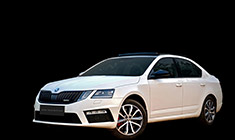News
Ownership review: 3rd gen Honda City V Exclusive MT
The side profile was a bit of a mixed bag. The overall profile of the car is actually quite low slung for a 3-box sedan.
BHPian vishy76 recently shared this with other enthusiasts.
The 3rd Generation Honda City can be had for anywhere between Rs. 2-4L in the used car market.
What you will like:
- Arrow shot head design brings in good proportions and has aged very well in general.
- Creamy and revv happy 1.5L I-VTEC L15 engine. A refined mill & a fast performer on the open road.
- Safety features such as 2 airbags+ABS were standard across all variants.
- V exclusive (the variant featured in this review) got goodies such as leather seats over and above the USB equipped stereo, steering mounted controls, alloys and fog lamps the V already had.
- Class leading rear legroom & D-segment sedan rivaling boot space.
- Honda’s bulletproof reliability & above average after sales experience.
What you won’t like:
- Missed out on some must haves for its time. CD Player, Climate control et al.
- A diesel engine would have made an already popular generation of the City even more revered.
- Poor ground clearance paired with a soft rear suspension setup. A recipe for disaster even on average sized speed breakers.
- Sheet metal quality wasn’t the greatest. Examples living by the coastline or in humid climates can be rust magnets.
- High speed driving dynamics are far from the segment best. Unsettled rear end takes away some confidence.


Introduction:
The Honda City 2008 was one of those cars which I always admired, but never had the fortune of seeing in my garage. In 2009, my dad was looking to replace our aging Opel Corsa and had given serious thought to the idea of buying the 3rd gen city. There was no reason why the City would fly under a prospective buyer’s radar in the 7-10L segment. No reason, except for one. The lack of an oil burner! Rising fuel prices & my dad’s daily commute from Andheri East all the way to Nariman Point and back in peak traffic made the idea of buying a petrol seem obscene. Apart from the usual fuel economy difference between petrol and diesel, the price gulf between the costs of both fuels was wide too. This factor meant my old man eventually binned the idea of buying the City entirely and bought himself a Verna CRDI.
This is where 7 year old me thought my tryst with the City had ended even before it began. But that was not to be.
Fast forward to 2010 and our paths were going to intertwine again. My grandfather had assumed a senior position at the company he worked for, and he was offered a car as a convenience commodity for the same. I was the stereotypical kid in the family who was obsessed with cars, and thus, I was also kept abreast with the selection process. My grandfather had a 60-70K km old 2005 Maruti Suzuki WagonR 1.1 16V at the time. An absolute gem of a car and the best one he owned after the City in my opinion. He was looking to sell it off within 2-3 months to make way for the “company” car.
I won’t delve deep into the selection process since my grandfather’s company had a tie-up with the local Honda dealer (Aspen Honda) for cars. This was a fairly new development I believe, since the company parking lot was otherwise filled with Corollas, Innovas and a couple of Fords and Marutis. The Honda Jazz was evaluated simply because my grandfather thought it would be an easier car for him to drive around. However, he was also offered a chauffeur by the company and it was thus concluded that the City would be a better deal for this reason alone.
I don’t have specific details pertaining to the booking date and the process, but I do remember the car came home somewhere in November, 2010. Nobody except for my grandfather knew which variant had been booked (except for the fact that it was a manual and that it was silver). I was in Vadodara at the time on account of Diwali and I believe I was told only a day in advance about the car delivery.
What was supposed to be a short and sweet delivery affair, turned out to be quite a long process. I waited for around 3 hours before I eventually heard the meek Honda horn and saw the car pulling into our lane. I don’t have the strongest of memories, but this incident for some reason is crystal clear in my head as I type this. It’s as if the entire incident is replaying and flashing upon my inner eye. The Honda was home! And to add to the surprise, it seemed to be a variant I had never seen before. The car had fog lamps, steering mounted controls and a leather wrapped steering. All of which theoretically meant it should have been the “V” variant. However, over and above all this, it had a leather wrapped gearknob, full leather interiors and an exterior chrome package which had the windowline and the exhaust tip in chrome. A look at the rear and the badging said “V’ but with “exclusive' ' underneath it.
My honeymoon period with the car was short lived since I had to make a return back to base. The City remained unused for almost a month, before a chauffeur who had the skill to reverse it out of the tight parking spot of our society was found. Incidentally, he stayed for almost the entire tenure of the car ownership, being relieved and transferred only some time after the COVID 2nd wave as my grandfather retired from his full time job.
Exteriors:
The Honda City’s run in India, when it comes to exteriors has been a mixed bag. The first gen City (codenamed the SX8) had a rather simplistic design with clean and soft lines. Typical Jap sedan design philosophy. The SX8 facelift (where the famous 1.5 SOHC VTEC debuted) assumed a much more aggressive design language, with wide clear lens headlamps and an aggressive front bumper dominating the front end, and a mean set of clear lens tail lamps finishing off the rear profile. All in all, the SX8 facelift is the definition of a quintessential low slung Japanese sedan for me and it probably always will be.
The 2nd gen City for India, popularly known as the dolphin, was a far cry from its predecessor in terms of design. The pre-facelift 2nd gen especially looked bland to me, though it still holds bragging rights for having the highest quality interiors seen in any generation of the Honda City. The IDSI motor debuted with this generation, though the famous VTEC was still available IIRC.
The 3rd gen came along in 2008. It seemed as if the 3rd gen had brought back the design flair that its predecessor was missing on. The very aggressive front end with the arrow shot head design philosophy, the headlamps merging into the grille seamlessly, the uniquely shaped ORVMs and the lack of chrome anywhere on the front end! The City now also boasted of 2 airbags + ABS as standard across variants, not something you would see on many cars back in 2008! The IDSI engine had been binned in favour of what Honda said was a reworked engine, having the block from the IDSI but a VTEC head. This engine was claimed to have the best mix of performance and fuel efficiency. TBH, this is one statement I agree with cent per cent. The same engine continued across 2 entire generations of the City for a little more than a decade, and still soldiers on in the 4th generation City.
Design:
The 3rd generation Honda City followed the global Honda design language and borrowed a lot of cues from what was the global Honda Civic back then on sale in Europe. This Civic never made it to India. The front is characterized by the slim headlamps which originate at the grille and stretch quite far back towards the fender. The bumper sports a set of seamlessly integrated fog lamps, something which is quite a rarity when it comes to car designs. The variants which do not get fog lamps don’t get a conspicuous blank plastic insert to remind you that they aren’t there (a trait that the facelift unfortunately lost). The grille was quite large by 2008 standards, but it wasn’t really in your face as it was sprayed in a rather dull shade of grey. This is one of the reasons why I prefer the pre-facelift 3rd gen to the facelift (Higher variants of the facelift had the entire grille in chrome!).
The side profile was a bit of a mixed bag. The overall profile of the car is actually quite low slung for a 3-box sedan. However, the bulky rear end does make the car look undertyred (though the rim size was on par with what the competition offered except for the SX4). The 5-spoke 15 inch alloys on the V variant looked classy. Even the lower variants got 15 inch rims IIRC, but those were steelies with wheel caps that had a neutral design. I am used to seeing the latter now, since a majority of the Citys I have seen on the road are the base or the mid variants.
The rear end was what polarised opinions. The stubby boot with the squared off tail lamps is something that I didn’t mind in the least, but it does stand out when you compare it to the low slung front end design and the sharply raked front windscreen.
Overall, I would say I rate the design of the 3rd generation City between the SX8 facelift and the 5th generation. It has aged well largely, doesn’t have any garish design elements (fat chrome moustache for instance) and has a tinge of Europeanness to it if I may dare say so. If I had to rate all Citys in terms of design, here’s how it would go:
1st gen facelift > 3rd gen > 5th gen > 3rd gen facelift > 4th gen facelift > 4th gen> 1st gen > 2nd gen facelift > 2nd gen.
Build quality:
The overall build quality of the 3rd generation City can be termed as acceptable. Panel gaps are kept in check in most areas. The thickness of sheet metal is more than successive generations, but it is nowhere in the league of the Vento or Linea. The doors shut with a rather hollow thud, a noise that almost borders on sounding more like a “clunk”. Again, it’s not as bad as the 4th generation City, where the doorpads move while rolling the windows down or up or the vinyl on the B-pillar trim peels off, but it is nowhere in the league of its European rivals in this aspect at all.
Additionally, as already indicated before, the City does have a bad habit of rusting. This example has spent most of its life away from the coast in very dry climates, and has thus not shown much signs of rusting in 12 years of ownership. But, cars which live near the coastline or in humid climates do tend to develop rust especially in the front cowling area which tends to get choked with dry leaves and twigs. The area around the wiper washer nozzles is also notorious for paint bubbling and rusting.
Front end gets the arrow shot head design treatment with the headlamps merging cleanly into the wide front grille. Absence of chrome is very much appreciated:

Three slatte grille is sprayed in a neutral shade of gunmetal grey. Adds to the sporty appeal and conceals its size rather well. The facelift had the entire grille in chrome (something that took a lot of time to grow on me):
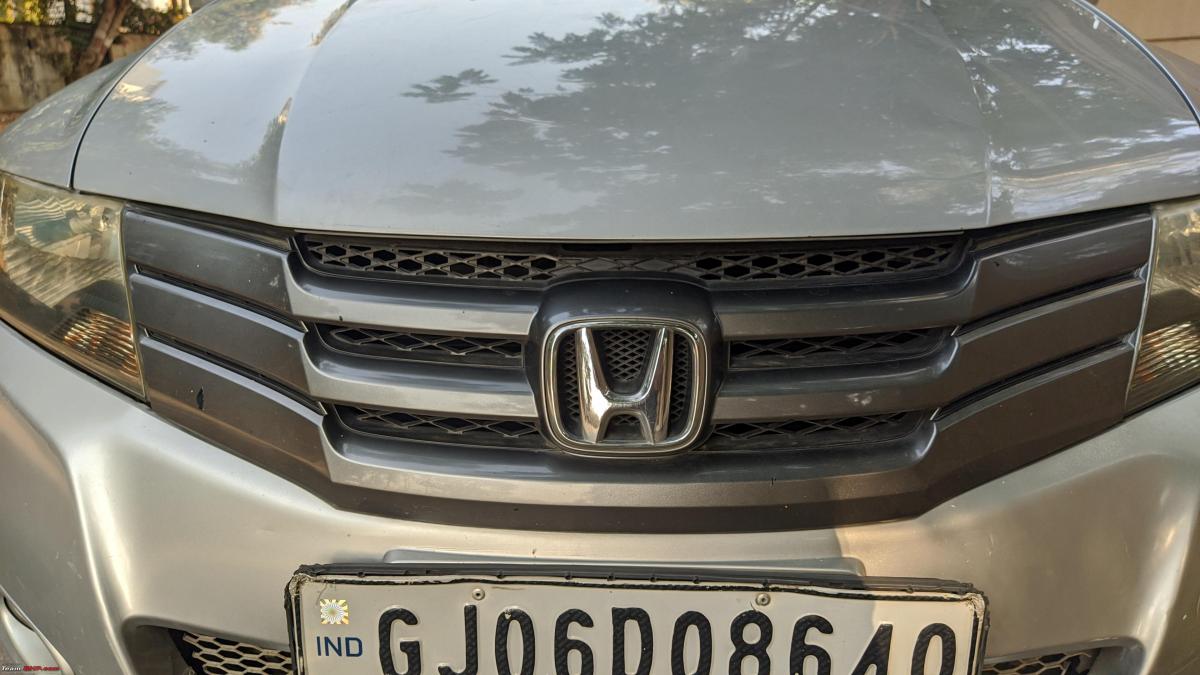
Smoked single barrel headlamps look swell. Unfortunately, these haven't stood the test of time. Lots of fading on the reflector bowl and some yellowing on the lens. Overall performance as a result has deteriorated severely. Don't miss the neatly integrated city light at the top left (indicator is at the bottom right):

Conventional wipers offer good sweep. The wiper blade sizes for the driver & passenger side are 24'' and 14 '' respectively:
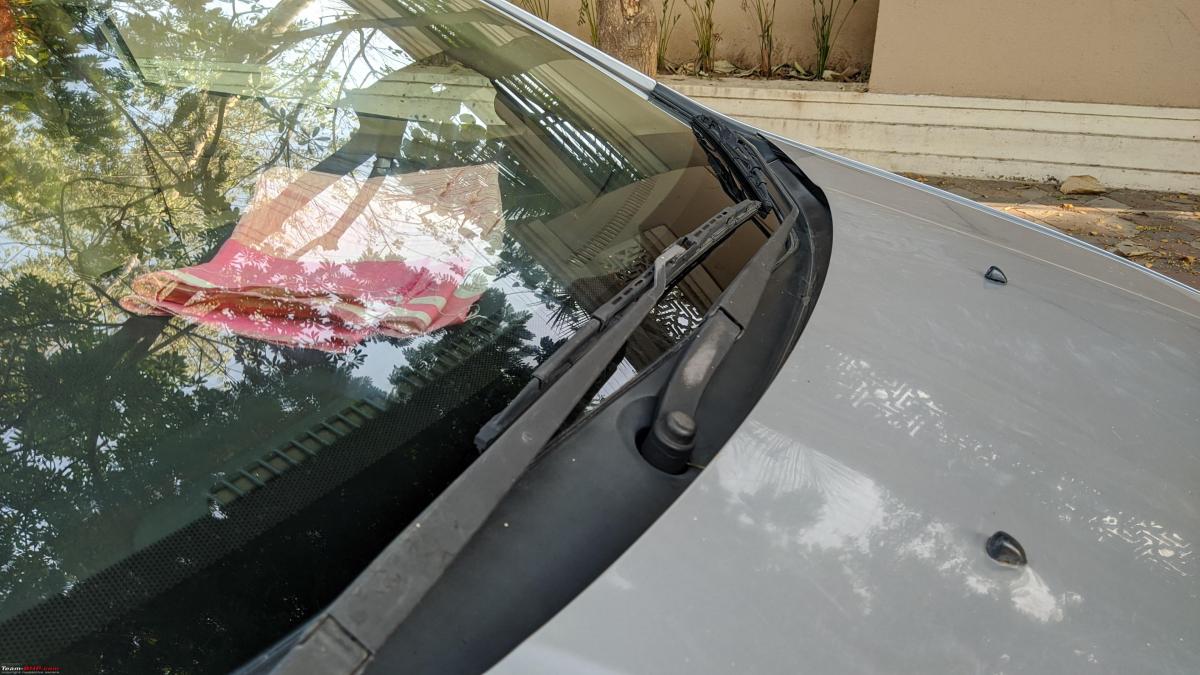
Washer jets are not tucked away under the cowl panel. They rest on the bonnet. Any leaks in the washer nozzle plumbing need to be remedied ASAP as it can cause paint bubbling around this area:

Fog lamps are rather small, but very well integrated. Variants which do not get fog lamps have a separate design for the front bumper. No ugly black plastic blanks to remind you they are missing:

The bumper of the 'S' variant. No blanks for the fog lamps here. Image credits to BHPian bluevolt:

Tow hook cover has a notch indicating where to pry it open:

Honda did do a bit of foolery while designing this bumper. The lower air dam is integrated into the bumper instead of being a separate trim piece (facelift fixed this flaw). As a result, if the air dam gets damaged, the entire bumper needs to go. Dogs bit the air dam fins off in this case. Had to do jugaad and put this mesh to protect the radiator:

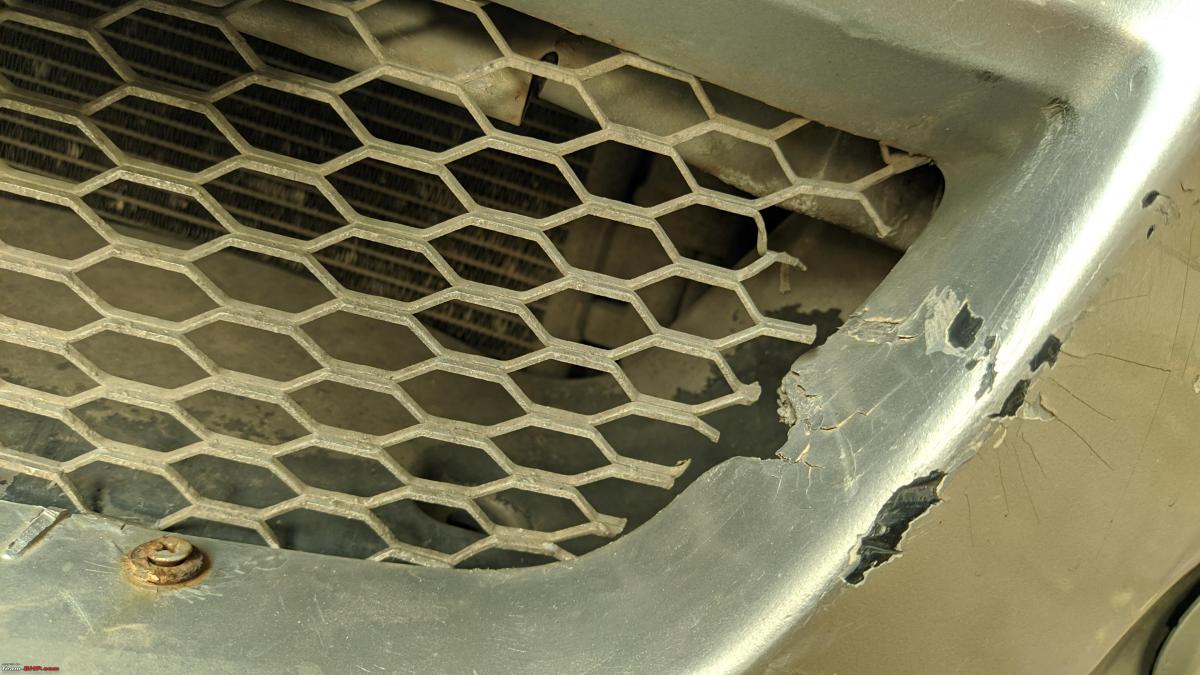
Underbody is not the tidiest. There are trim pieces covering the areas to the left and right of the engine and GB as shown, but nothing to protect them in case of a direct impact:

The best angle to view the City from IMO. Bears a very strong resemblance to the European Civic of the time:

Side profile looks good for the most part, barring the stubby boot and the tyres which do look a size smaller than they should be thanks to all that sheet metal on top:

15-inch 5-spoke alloys look classy. Shod with crappy MRF ZVTV 175/65 R15 tyres:

The City belongs to an era before the side indicators moved to the ORVMs. No competitor had these IIRC (facelift did on the higher variants):

The ORVMs are a good blend of aesthetics and function. They are fairly tall and wide. Offer a good field of vision. As with most cars of the time, they are electrically adjustable, not foldable:

Sexy looking chrome door handles. Chunky to hold, though they don't feel very solid to operate. Two of them (rear ones) have also come a bit loose now after 12 years of use:

The exclusive variant got an exterior chrome package that included the windowline with the accompanying trim pieces and the bootlid. Quality of chrome itself was good, but the chrome beadings on the windowline came loose. Had to be stuck back again:

Body coloured mudflaps are a nice touch. Very well integrated. Unfortunately, these have been victims of poor ground clearance:

Stubby antenna is a welcome move as opposed to the long and ugly whip type ones offered on most other cars back then. This one has unfortunately been vandalized by canines:
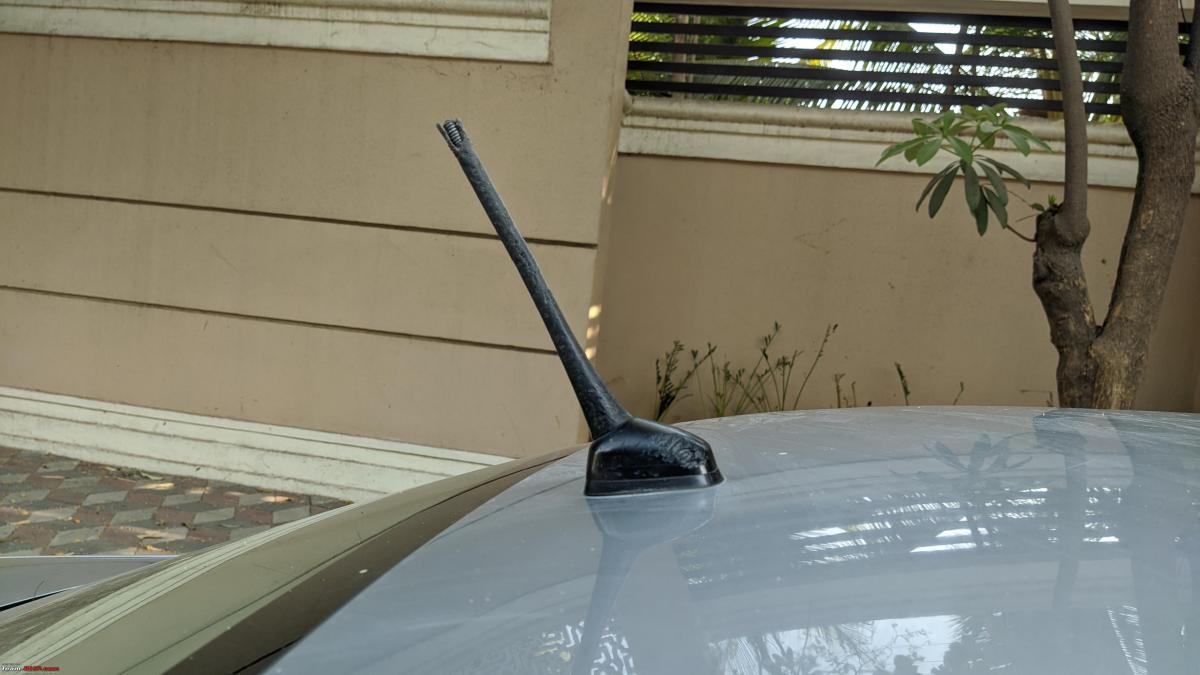
Front wheel arches get full cladding. The dampers seem to have been changed since the strut mounts (inside the engine bay) and the dust cover (seen here) seem to be fairly new. Nevertheless, the front suspension continues to create a racket on less than ideal roads:

Rear wheel arches are bare naked. You can even see the fuel lines feeding into and emerging out of the tank here:

Fuel lid is a push to open type and is linked to the central locking system. Came as a surprise to me (I expected a manual release lever near to the bottom of the driver's seat as with most Asian cars):
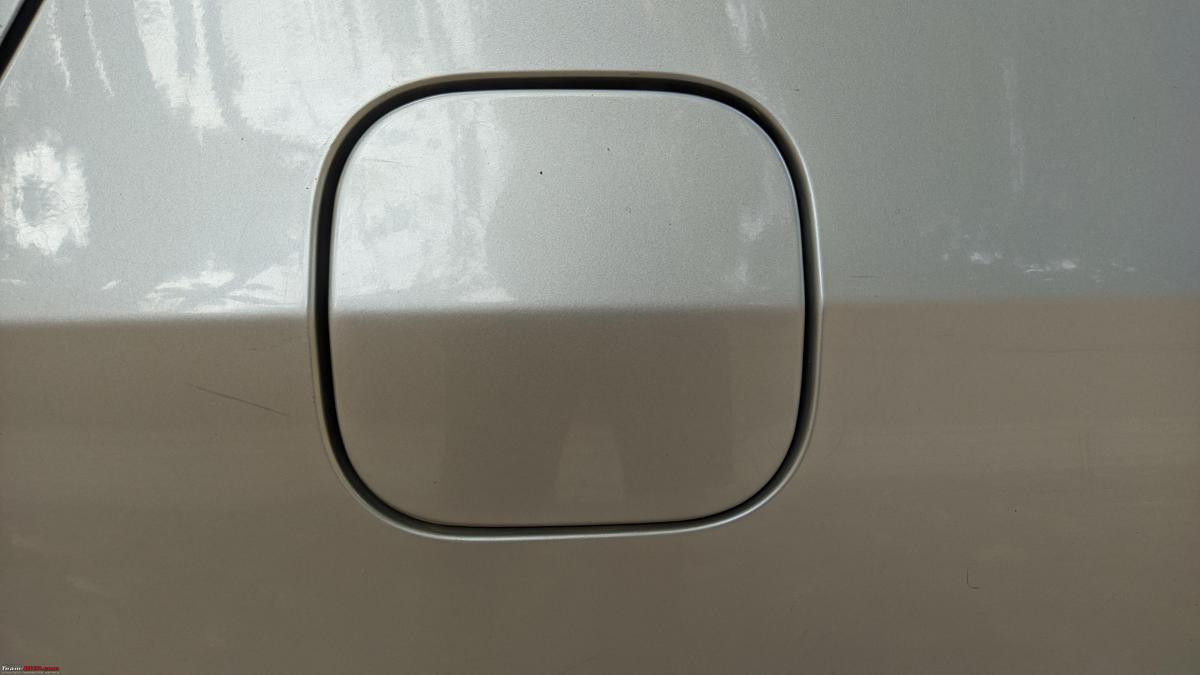
Rear end polarised opinions at launch unlike the instantly likeable front. I personally love the way it looks. Unlike the front, there is an overdose of chrome here:

The 'exclusive' badge sits below the City V nomenclature. Not seen many of these special editions TBH:

The i-VTEC badging sits to the right:

Too much of chrome here. The chrome garnish at the bottom of the tailgate and at the top of the number plate housing actually make the rear a lot more "chrome heavy" than the front (most cars have it the opposite way). I would do away with atleast the bottom garnish:

Exhaust tip gets a chrome cover. Won't complain here since the original exhaust tip seems terribly puny:

Continue reading BHPian vishy76's review of his 3rd gen Honda City V Exclusive MT for BHPian comments, insights and more information.























